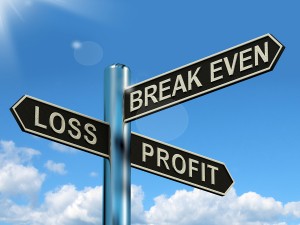Break even point or BEP is the point where you have zero loss or profit. At break even point, total revenue of the company will be equal to total cost i.e. fixed and variable costs.
Beyond this point, the company will generate profit. Similarly if a company is not able to touch Break Even Point then it will have loss, as total cost will be higher that its total revenue.
 A company can reach Break Even Point by selling more of it’s product to customer. It will sell products till BEP just to cover up the expenses i.e. not making any profit or loss.
A company can reach Break Even Point by selling more of it’s product to customer. It will sell products till BEP just to cover up the expenses i.e. not making any profit or loss.
Once Break Even Point or BEP achieved, the company will start making profit.
On the other hand, company selling less or not able to touch its BEP makes losses.
To find out the break even point or BEP at which the company will have no profit or loss, you need to first determine its selling price per unit, fixed cost and variable cost per unit.
Fixed costs are the expenses which do not change with the level of sales. Variable costs are those expenses which change with the level of sales.
To calculate BEP in units, we need to divide fixed costs by the contribution per unit.
Contribution per unit is determined by subtracting variable cost per unit from selling price per unit of the product. Contribution per unit is also called contribution margin.
Formula for BEP = Fixed Cost / (Price per unit – variable cost per unit)
Example of BEP
X ltd has calculated its fixed cost as Rs. 1, 00,000, variable cost as Rs. 10 per unit and selling price per unit as Rs. 20.
BEP in units = Fixed cost / (Selling price per unit – variable cost per unit) = Rs. 1, 00,000 / (20-10) = 10, 000 units
If the company is selling 10, 000 units (i.e. BEP for the product) then it will generate Rs. 2, 00,000 to cover its fixed expenses of Rs. 1, 00,000 and variable cost of Rs. 1, 00,000 (i.e. 10000 * 10). Beyond this Point (i.e. BEP) company will have profit.
How BEP formula is derived
We know, our total revenue will be equal to our total cost plus profit. From this we can derive formula to calculate BEP.
Total revenue = Total Cost + Profit
Selling price per unit * number of units = (variable cost * number of units) + fixed cost + Profit
At break even point or BEP we know that profit will be zero. So by taking profit as zero we can derive our formula as below;
Selling price* number of units = (Variable cost* number of units) + fixed cost
Selling price = variable cost + (fixed cost/ number of units)
Selling price – variable cost = fixed cost / number of units
Fixed cost / (Selling price – variable cost) = Number of units or BEP
If you are going to start your own business then you can calculate your Break Even Point by estimating your selling price, variable and fixed costs. BEP will give you an excellent idea about your cost structure at the level of sales at which you can cover up your cost.
After knowing the BEP or break even point, you can easily estimate your sales to calculate the number of days you will take to reach this point. As your selling price and cost changes frequently, you need to recalculate BEP to know what to do to make profit.